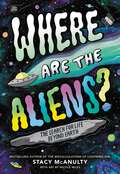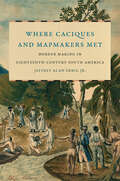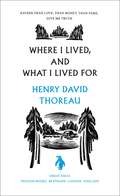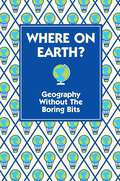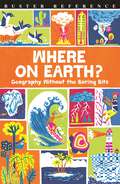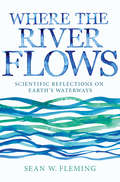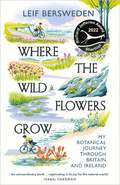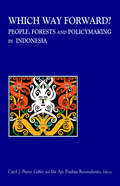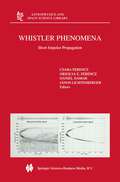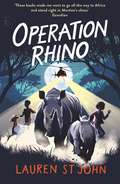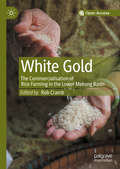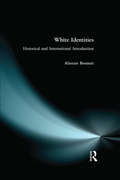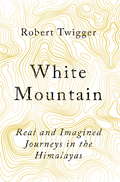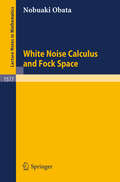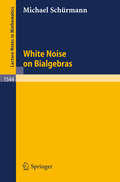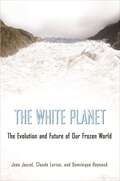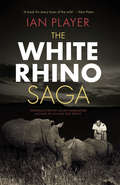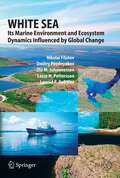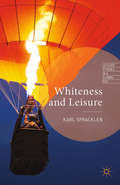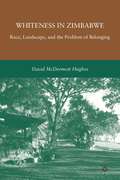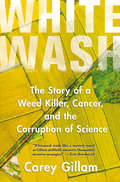- Table View
- List View
Where Are the Aliens?: The Search for Life Beyond Earth
by Stacy McAnultyA fun-filled, highly illustrated, science-based exploration into one of the universe&’s greatest mysteries—does life exist beyond Earth?—from bestselling and award-winning author Stacy McAnulty. Spoiler: Scientists haven&’t discovered life beyond Earth, not even a single teeny-tiny organism. But there&’s a whole lot of outer space, and humans have searched only a fraction of a fraction of it. So do you believe in the possibility of life out there? Or do you think Earth is perfectly unique in its ability to grow organisms?Where Are the Aliens? takes readers on a journey of theories and discoveries, from the big bang and primordial soup, to how the ancient Greeks considered the cosmos, to the technology used today to listen and (possibly!) communicate with far-off exoplanets. Packed with playful illustrations and fascinating factoids, this is the perfect book for anyone who has ever looked up and asked, "What's out there?"
Where Caciques and Mapmakers Met: Border Making in Eighteenth-Century South America (The David J. Weber Series in the New Borderlands History)
by Jeffrey Alan ErbigDuring the late eighteenth century, Portugal and Spain sent joint mapping expeditions to draw a nearly 10,000-mile border between Brazil and Spanish South America. These boundary commissions were the largest ever sent to the Americas and coincided with broader imperial reforms enacted throughout the hemisphere. Where Caciques and Mapmakers Met considers what these efforts meant to Indigenous peoples whose lands the border crossed. Moving beyond common frameworks that assess mapped borders strictly via colonial law or Native sovereignty, it examines the interplay between imperial and Indigenous spatial imaginaries. What results is an intricate spatial history of border making in southeastern South America (present-day Argentina, Brazil, and Uruguay) with global implications. Drawing upon manuscripts from over two dozen archives in seven countries, Jeffrey Erbig traces on-the-ground interactions between Ibero-American colonists, Jesuit and Guarani mission-dwellers, and autonomous Indigenous peoples as they responded to ever-changing notions of territorial possession. It reveals that Native agents shaped when and where the border was drawn, and fused it to their own territorial claims. While mapmakers' assertions of Indigenous disappearance or subjugation shaped historiographical imaginations thereafter, Erbig reveals that the formation of a border was contingent upon Native engagement and authority.
Where I Lived, and What I Lived For
by Henry ThoreauThroughout history, some books have changed the world. They have transformed the way we see ourselves - and each other. They have inspired debate, dissent, war and revolution. They have enlightened, outraged, provoked and comforted. They have enriched lives - and destroyed them. Now Penguin brings you the works of the great thinkers, pioneers, radicals and visionaries whose ideas shook civilization and helped make us who we are.Thoreau's account of his solitary and self-sufficient home in the New England woods remains an inspiration to the environmental movement - a call to his fellow men to abandon their striving, materialistic existences of 'quiet desperation' for a simple life within their means, finding spiritual truth through awareness of the sheer beauty of their surroundings.
Where On Earth?: Geography Without the Boring Bits
by James DoyleWhere on Earth? is Jam-packed with all of geography's greatest hits, with all the boring bits taken out. From lava-spewing volcanoes to cool ways to remember the world's highest mountains, longest rivers and most desolate deserts - plus all the countries and continents in which these fantastic features are found. The perfect learning companion to help all school children get to grips with discovering the world around them.
Where On Earth?: Geography Without the Boring Bits
by James DoyleWhere on Earth? is jam-packed with all of geography's greatest hits, with all the boring bits taken out. From how to make a raindrops to cool ways to remember the world's wonderful waterfalls, longest rivers and most desolate deserts - plus all the countries and continents in which these fantastic features are found. The perfect learning companion to help all school children get to grips with discovering the world around them.
Where the River Flows: Scientific Reflections on Earth's Waterways
by Sean W. FlemingThe vital interconnections that rivers share with the land, the sky, and usRivers are essential to civilization and even life itself, yet how many of us truly understand how they work? Why do rivers run where they do? Where do their waters actually come from? How can the same river flood one year and then dry up the next? Where the River Flows takes you on a majestic journey along the planet's waterways, providing a scientist's reflections on the vital interconnections that rivers share with the land, the sky, and us.Sean Fleming draws on examples ranging from common backyard creeks to powerful and evocative rivers like the Mississippi, Yangtze, Thames, and Congo. Each chapter looks at a particular aspect of rivers through the lens of applied physics, using abundant graphics and intuitive analogies to explore the surprising connections between watershed hydrology and the world around us. Fleming explains how river flows fluctuate like stock markets, what "digital rainbows" can tell us about climate change and its effects on water supply, how building virtual watersheds in silicon may help avoid the predicted water wars of the twenty-first century, and much more. Along the way, you will learn what some of the most exciting ideas in science—such as communications theory, fractals, and even artificial life—reveal about the life of rivers.Where the River Flows offers a new understanding of the profound interrelationships that rivers have with landscapes, ecosystems, and societies, and shows how startling new insights are possible when scientists are willing to think outside the disciplinary box.
Where the River Flows: Scientific Reflections on Earth's Waterways
by Sean W. FlemingThe vital interconnections that rivers share with the land, the sky, and usRivers are essential to civilization and even life itself, yet how many of us truly understand how they work? Why do rivers run where they do? Where do their waters actually come from? How can the same river flood one year and then dry up the next? Where the River Flows takes you on a majestic journey along the planet's waterways, providing a scientist's reflections on the vital interconnections that rivers share with the land, the sky, and us.Sean Fleming draws on examples ranging from common backyard creeks to powerful and evocative rivers like the Mississippi, Yangtze, Thames, and Congo. Each chapter looks at a particular aspect of rivers through the lens of applied physics, using abundant graphics and intuitive analogies to explore the surprising connections between watershed hydrology and the world around us. Fleming explains how river flows fluctuate like stock markets, what "digital rainbows" can tell us about climate change and its effects on water supply, how building virtual watersheds in silicon may help avoid the predicted water wars of the twenty-first century, and much more. Along the way, you will learn what some of the most exciting ideas in science—such as communications theory, fractals, and even artificial life—reveal about the life of rivers.Where the River Flows offers a new understanding of the profound interrelationships that rivers have with landscapes, ecosystems, and societies, and shows how startling new insights are possible when scientists are willing to think outside the disciplinary box.
Where the Wildflowers Grow: My Botanical Journey Through Britain and Ireland
by Leif Bersweden'This bicycle Odyssey of Britain and Ireland's wild flora is joyous, inspirational and beautifully observed.' - Peter Marren, author of After They've Gone'The Wildflowers of Britain have a new champion.' - Lee Schofield, author of Wild Fell'A heart-warming, fascination-inducing read from start to finish.' - Lucy Lapwing'An extraordinary book... captivating in its joy for the natural world.' - Isabel Hardman'When was the last time you stopped and noticed a wild plant?'An intriguing and timely exploration of the importance of Britain and Ireland's plant life.Leif Bersweden has always been fascinated by wild plants. From a young age, his afternoons were spent hunting for and cataloguing the plants in his local area. But it is a landscape that is fast disappearing.Climate change, habitat destruction and declining pollinator populations mean that the future for plant life looks bleaker than ever before. Many of us are also unable to identify, or even notice, the plants that grow around us.Now a botanist, Leif decides to go on a mission, to explore the plants that Britain and Ireland have to offer and to meet those who spend time searching for them. Over the course of a year, Leif goes on a journey around the UK and Ireland, highlighting the unique plants that grow there, their history and the threats that face them. His journey takes him from the Cornish coast to the pine forests of Scotland - even to the streets of London, proving that nature can be found in the most unexpected places. Along the way, Leif highlights the joy and positivity that can be found through understanding nature and why it is so desperately important to protect our wildflowers.
Which Way Forward: People, Forests, and Policymaking in Indonesia
by Carol J. Pierce ColferIndonesia contains some of Asia‘s most biodiverse and threatened forests. The challenges result from both long-term management problems and the political, social, and economic turmoil of the past few years. The contributors to Which Way Forward? explore recent events in Indonesia, while focusing on what can be done differently to counter the destruction of forests due to asset-stripping, corruption, and the absence of government authority. Contributors to the book include anthropologists, economists, foresters, geographers, human ecologists, and policy analysts. Their concerns include the effects of government policies on people living in forests, the impact of the economic crisis on small farmers, links between corporate debt and the forest sector, and the fires of the late 1990s. By analyzing the nation‘s dramatic circumstances, they hope to demonstrate how Indonesia as well as other developing countries might handle their challenges to protect biodiversity and other resources, meet human needs, and deal with political change. The book includes an afterword by Emil Salim, former Indonesian Minister of State for Population and the Environment and former president of the Governing Council of the United Nations Environment Programme. A copublication of Resources for the Future and the Center for International Forestry Research (CIFOR) and the Institute for Southeast Asian Studies (ISEAS).
Which Way Forward: People, Forests, and Policymaking in Indonesia
by Carol J. Pierce ColferIndonesia contains some of Asia‘s most biodiverse and threatened forests. The challenges result from both long-term management problems and the political, social, and economic turmoil of the past few years. The contributors to Which Way Forward? explore recent events in Indonesia, while focusing on what can be done differently to counter the destruction of forests due to asset-stripping, corruption, and the absence of government authority. Contributors to the book include anthropologists, economists, foresters, geographers, human ecologists, and policy analysts. Their concerns include the effects of government policies on people living in forests, the impact of the economic crisis on small farmers, links between corporate debt and the forest sector, and the fires of the late 1990s. By analyzing the nation‘s dramatic circumstances, they hope to demonstrate how Indonesia as well as other developing countries might handle their challenges to protect biodiversity and other resources, meet human needs, and deal with political change. The book includes an afterword by Emil Salim, former Indonesian Minister of State for Population and the Environment and former president of the Governing Council of the United Nations Environment Programme. A copublication of Resources for the Future and the Center for International Forestry Research (CIFOR) and the Institute for Southeast Asian Studies (ISEAS).
Whistler Phenomena: Short Impulse Propagation (Astrophysics and Space Science Library #262)
by C. Ferencz O. Ferencz D. Hamar J. LichtenbergerIn this volume, the authors present theoretical explanations for a few basic problems connected with the propagation of extra wide band, short impulses in linear media, and with the propagation of whistlers and megawhistlers in plasmas. In addition, the book provides an overview of ground and space based measurements, digital processing and signal analysis. The theoretical treatment in this volume is original in the sense that, unlike former solutions, the authors present a fundamentally non-monochromatic approach. A key feature of this approach is the application of the `Laplace Transformation' and the `Method of Inhomogeneous Basic Modes' to solve Maxwell's equations. It is shown that when the obtained theoretical results are applied to digital recordings, the wave analysis process becomes so flexible that it can also be used to investigate other wave propagation problems. These are both terrestrial phenomena (like atmospheric and seismic activity, buried target detection, etc.) and phenomena in space (planetary, interplanetary, plasmaspheric, whistler and megawhistler propagation). The book is aimed at a technical and professional audience working on whistler science and/or wave propagation problems.
The White Giraffe Series: Book 5 (The White Giraffe Series)
by Lauren St JohnThe fifth African adventure in Lauren St John's bestselling THE WHITE GIRAFFE series.When Sawubona's white rhinos are attacked, the poachers leave behind a terrified calf. Devastated but determined to help, Martine and Ben agree to take the rhino baby to a sanctuary near the Golden Gate Highlands National Park.But the sanctuary is hiding a precious secret - one that must be guarded from the poachers at all costs. When the secret gets out, Martine and Ben find themselves in the fight of their lives to save one of the rarest animals on earth. But who can they trust?A magical and heartwarming adventure about saving endangered species.
White Gold: The Commercialisation of Rice Farming in the Lower Mekong Basin
by Rob CrambThis open access book is about understanding the processes involved in the transformation of smallholder rice farming in the Lower Mekong Basin from a low-yielding subsistence activity to one producing the surpluses needed for national self-sufficiency and a high-value export industry. For centuries, farmers in the Basin have regarded rice as “white gold”, reflecting its centrality to their food security and well-being. In the past four decades, rice has also become a commercial crop of great importance to Mekong farmers, augmenting but not replacing its role in securing their subsistence. This book is based on collaborative research to (a) compare the current situation and trajectories of rice farmers within and between different regions of the Lower Mekong, (b) explore the value chains linking rice farmers with new technologies and input and output markets within and across national borders, and (c) understand the changing role of government policies in facilitating the on-going evolution of commercial rice farming. An introductory section places the research in geographical and historical context. Four major sections deal in turn with studies of rice farming, value chains, and policies in Northeast Thailand, Central Laos, Southeastern Cambodia, and the Mekong Delta. The final section examines the implications for rice policy in the region as a whole.
White Identities: An Historical & International Introduction
by Alastair BonnettWhite Identities provides a comprehensive overview of this debate, drawing together the various strands of recent research into an accessible but challenging introduction. The author argues that 'White Studies', as it is presently conceived, is an American project, reflecting American interpretations of race and history. However the book shows that the impact of white identities is international in scope and significance. Thus, only a thorough historical and international perspective on whiteness can provide a proper introduction to the subject, an introduction that has relevance to students worldwide.
White Identities: An Historical & International Introduction
by Alastair BonnettWhite Identities provides a comprehensive overview of this debate, drawing together the various strands of recent research into an accessible but challenging introduction. The author argues that 'White Studies', as it is presently conceived, is an American project, reflecting American interpretations of race and history. However the book shows that the impact of white identities is international in scope and significance. Thus, only a thorough historical and international perspective on whiteness can provide a proper introduction to the subject, an introduction that has relevance to students worldwide.
White Mountain: A Cultural Adventure Through The Himalayas
by Robert Twigger'Robert Twigger is not so much a travel writer as a thrill-seeking philosopher' EsquireThe Himalayas beckon and we go ... Some to make real journeys and others to make imaginary ones. These mountains, home to Buddhists, Bonpos, Jains, Muslims, Hindus, shamans and animists, to name only a few, are a place of pilgrimage and dreams, revelation and war, massacre and invasion, but also peace and unutterable calm.In an exploration of the region's seismic history, Robert Twigger unravels some of these real and invented journeys and the unexpected links between them. Following a meandering path across the Himalayas to its physical end in Nagaland on the Indian-Burmese border, Twigger encounters incredible stories from a unique cast of mountaineers and mystics, pundits and prophets. The result is a sweeping, enthralling and surprising journey through the history of the world's greatest mountain range.
White Noise Calculus and Fock Space (Lecture Notes in Mathematics #1577)
by Nobuaki ObataWhite Noise Calculus is a distribution theory on Gaussian space, proposed by T. Hida in 1975. This approach enables us to use pointwise defined creation and annihilation operators as well as the well-established theory of nuclear space.This self-contained monograph presents, for the first time, a systematic introduction to operator theory on fock space by means of white noise calculus. The goal is a comprehensive account of general expansion theory of Fock space operators and its applications. In particular,first order differential operators, Laplacians, rotation group, Fourier transform and their interrelations are discussed in detail w.r.t. harmonic analysis on Gaussian space. The mathematical formalism used here is based on distribution theory and functional analysis , prior knowledge of white noise calculus is not required.
White Noise on Bialgebras (Lecture Notes in Mathematics #1544)
by Michael SchürmannStochastic processes with independent increments on a group are generalized to the concept of "white noise" on a Hopf algebra or bialgebra. The main purpose of the book is the characterization of these processes as solutions of quantum stochastic differential equations in the sense of R.L. Hudsonand K.R. Parthasarathy. The notes are a contribution to quantum probability but they are also related to classical probability, quantum groups, and operator algebras. The Az ma martingales appear as examples of white noise on a Hopf algebra which is a deformation of the Heisenberg group. The book will be of interest to probabilists and quantum probabilists. Specialists in algebraic structures who are curious about the role of their concepts in probablility theory as well as quantum theory may find the book interesting. The reader should havesome knowledge of functional analysis, operator algebras, and probability theory.
The White Planet: The Evolution and Future of Our Frozen World
by Jean Jouzel Claude Lorius Dominique Raynaud Teresa Lavender FaganFrom the Arctic Ocean and ice sheets of Greenland, to the glaciers of the Andes and Himalayas, to the great frozen desert of Antarctica, The White Planet takes readers on a spellbinding scientific journey through the shrinking world of ice and snow to tell the story of the expeditions and discoveries that have transformed our understanding of global climate. Written by three internationally renowned scientists at the center of many breakthroughs in ice core and climate science, this book provides an unparalleled firsthand account of how the "white planet" affects global climate--and how, in turn, global warming is changing the frozen world. Jean Jouzel, Claude Lorius, and Dominique Raynaud chronicle the daunting scientific, technical, and human hurdles that they and other scientists have had to overcome in order to unravel the mysteries of past and present climate change, as revealed by the cryosphere--the dynamic frozen regions of our planet. Scientifically impeccable, up-to-date, and accessible, The White Planet brings cutting-edge climate research to general readers through a vivid narrative. This is an essential book for anyone who wants to understand the inextricable link between climate and our planet's icy regions.
The White Planet: The Evolution and Future of Our Frozen World
by Jean Jouzel Claude Lorius Dominique Raynaud Teresa Lavender FaganFrom the Arctic Ocean and ice sheets of Greenland, to the glaciers of the Andes and Himalayas, to the great frozen desert of Antarctica, The White Planet takes readers on a spellbinding scientific journey through the shrinking world of ice and snow to tell the story of the expeditions and discoveries that have transformed our understanding of global climate. Written by three internationally renowned scientists at the center of many breakthroughs in ice core and climate science, this book provides an unparalleled firsthand account of how the "white planet" affects global climate--and how, in turn, global warming is changing the frozen world. Jean Jouzel, Claude Lorius, and Dominique Raynaud chronicle the daunting scientific, technical, and human hurdles that they and other scientists have had to overcome in order to unravel the mysteries of past and present climate change, as revealed by the cryosphere--the dynamic frozen regions of our planet. Scientifically impeccable, up-to-date, and accessible, The White Planet brings cutting-edge climate research to general readers through a vivid narrative. This is an essential book for anyone who wants to understand the inextricable link between climate and our planet's icy regions.
The White Rhino Saga
by Ian PlayerThe White Rhino Saga - back in print after more than 30 years - is more relevant than ever as our rhino population faces a deadly poaching onslaught. With a new introduction by Julian Rademeyer and a 'missing chapter' never before published, a new generation of readers can enjoy and learn from the extraordinary story of how the white rhino was saved from extinction four decades ago. From Ian Player's first visit to the Umfolozi Game Reserve in South Africa's Zululand in 1952, the salvation of the white rhino from extinction became a personal obsession. The white rhino, the second largest animal in the world, had roamed over the southern half of the African continent in large numbers during the nineteenth century and before. By the 1960s fewer than five hundred remained, confined to 72 000 acres, not nearly enough territory for them to remain healthy and alive. The problem confronting Ian Player and his co-workers was twofold: how to repopulate the game reserves of Africa where white rhinos had once lived, and how to supply white rhinos to the zoos of the world. The techniques for capturing and transporting the huge animals are fascinating. The White Rhino Saga, Alan Paton writes in his foreword, 'is a book for every lover of the wild. The danger of captures, the disappointments, the ultimate successes, makes a splendid tale.' It is a tale of adventure, of Africa, of animals - and of the man who set out to save them.
White Sea: Its Marine Environment and Ecosystem Dynamics Influenced by Global Change (Springer Praxis Books)
by Nikolai Filatov Dmitry Pozdnyakov Olaf M. Johannessen Lasse H. Pettersson Leonid P. BobylevThis unique collaboration of Russian and Norwegian scientists examines the most recent data on the White Sea bathymetry, examines the ecosystem profile, and provides extensive historical marine and riverine data records. The book presents extensive data and numerical modelling simulations of the White Sea to provide a quantitative assessment of vulnerability of the Sea’s marine ecosystems, of future anthropogenic and climate change forcing.
Whiteness and Leisure (Leisure Studies in a Global Era)
by K. SpracklenThis book develops a new theory of instrumental whiteness and leisure. Empirical research is drawn upon to highlight whiteness across a comprehensive and internationally-grounded range of leisure practices. The book explores sports participation, sports media and sports fandom, informal leisure, outdoor leisure, music, popular culture and tourism.
Whiteness in Zimbabwe: Race, Landscape, and the Problem of Belonging
by D. HughesEuropean settler societies have a long history of establishing a sense of belonging and entitlement outside Europe, but Zimbabwe has proven to be the exception to the rule. Arriving in the 1890s, white settlers never comprised more than a tiny minority. Instead of grafting themselves onto local societies, they adopted a strategy of escape.
Whitewash: The Story of a Weed Killer, Cancer, and the Corruption of Science
by Carey GillamIn this volume, the author uncovers one of the most controversial stories in the history of food and agriculture, exposing new evidence of corporate influence. The author introduces readers to farm families devastated by cancers which they believe are caused by the chemical, and to scientists whose reputations have been smeared for publishing research that contradicted business interests. Readers learn about the arm-twisting of regulators who signed off on the chemical, echoing company assurances of safety even as they permitted higher residues of the pesticide in food and skipped compliance tests. And, in startling detail, the author reveals secret industry communications that pull back the curtain on corporate efforts to manipulate public perception.
